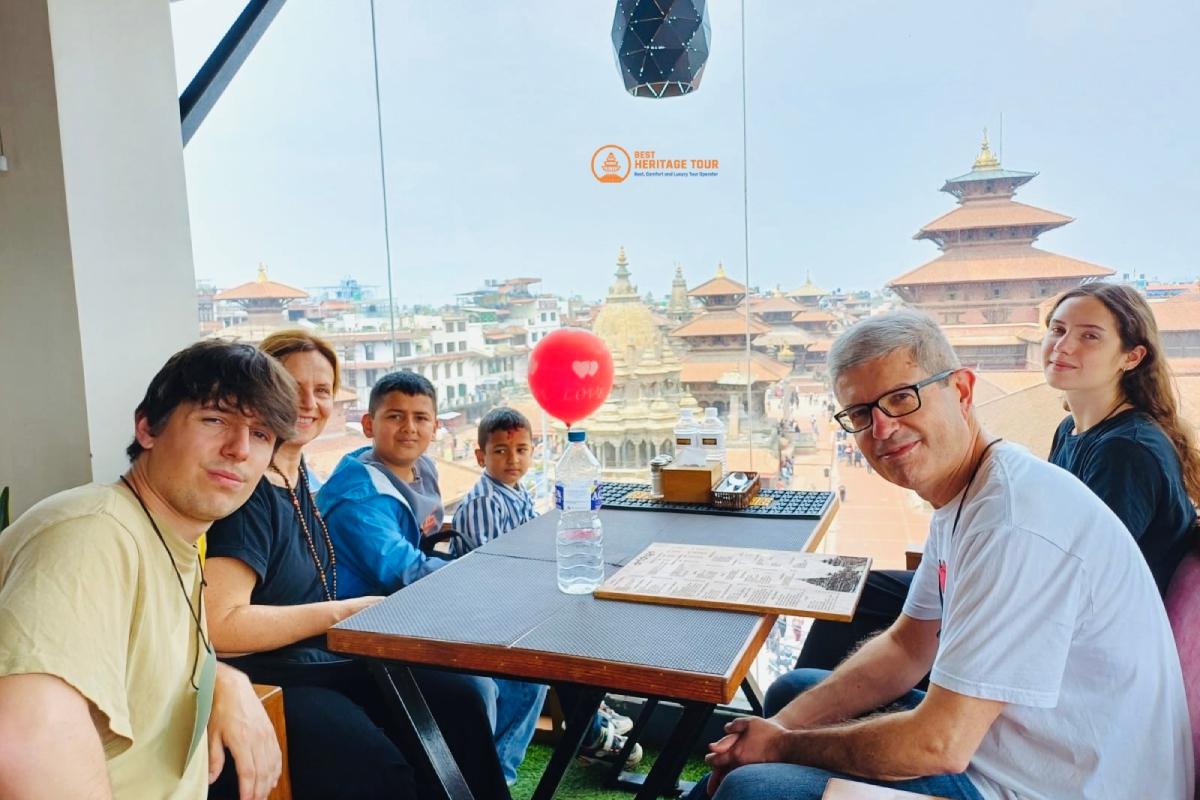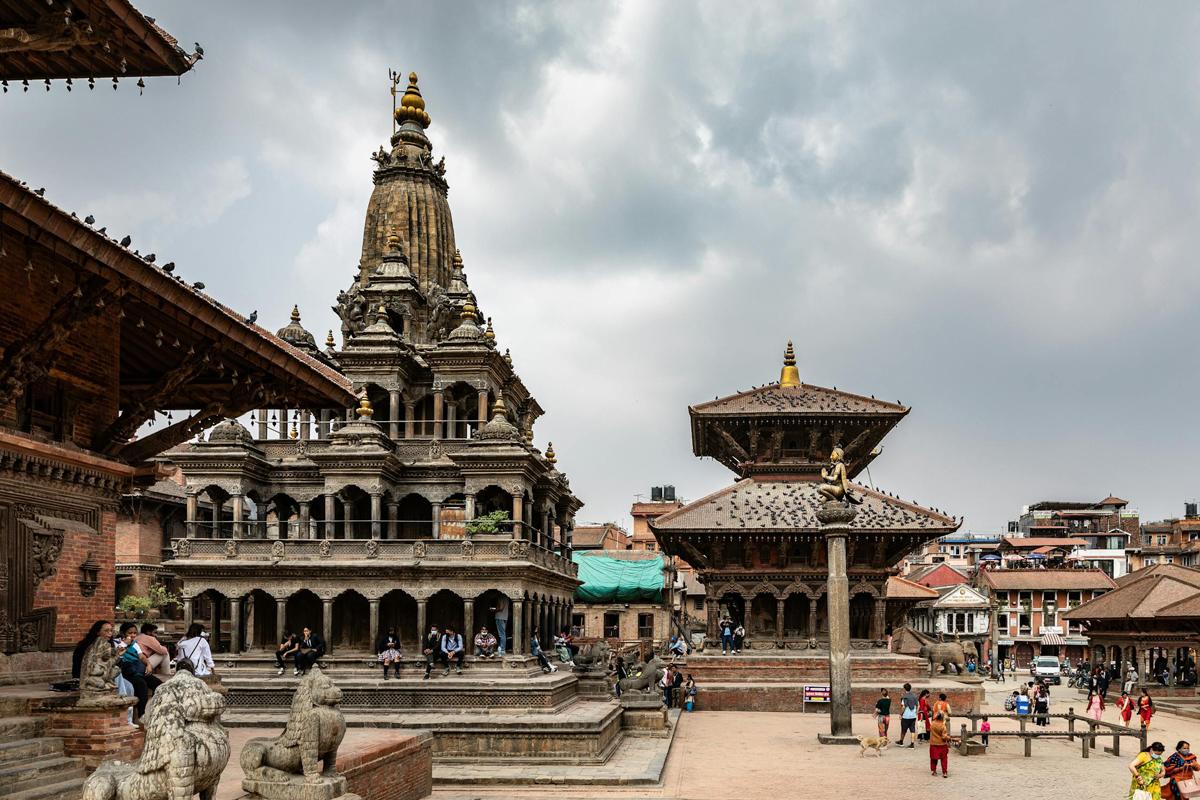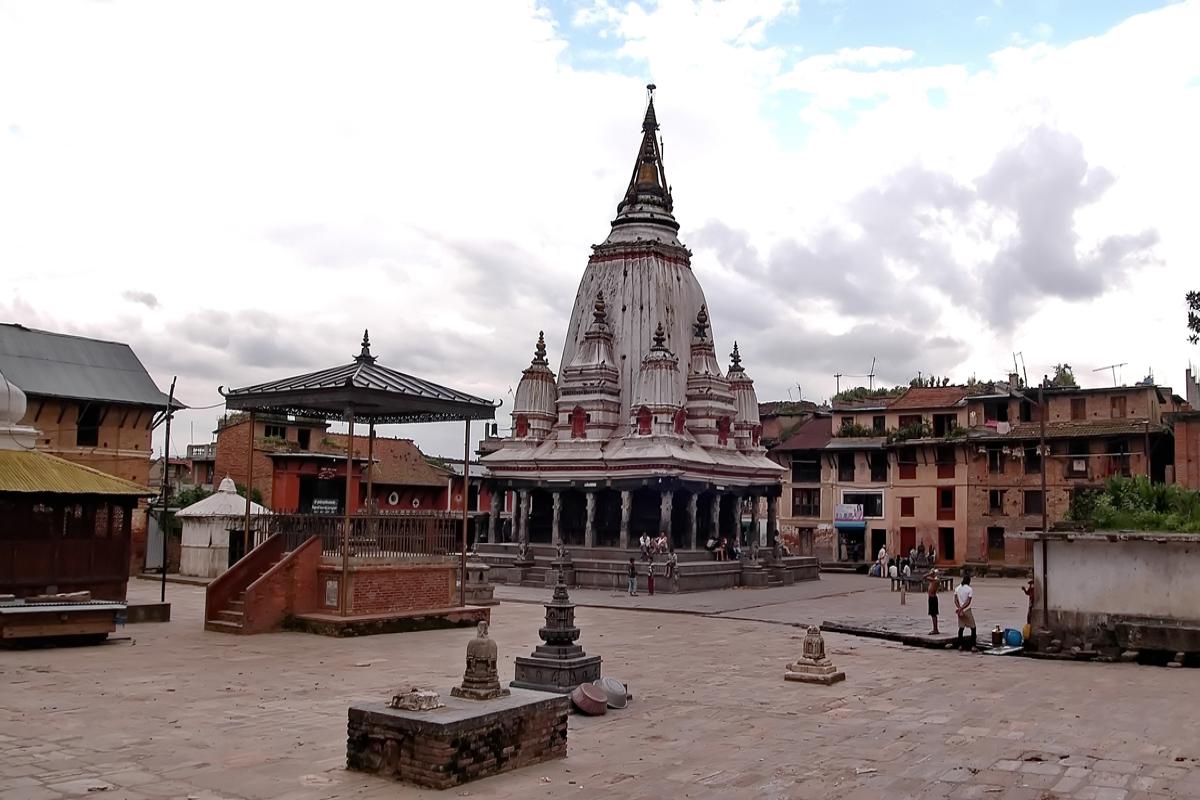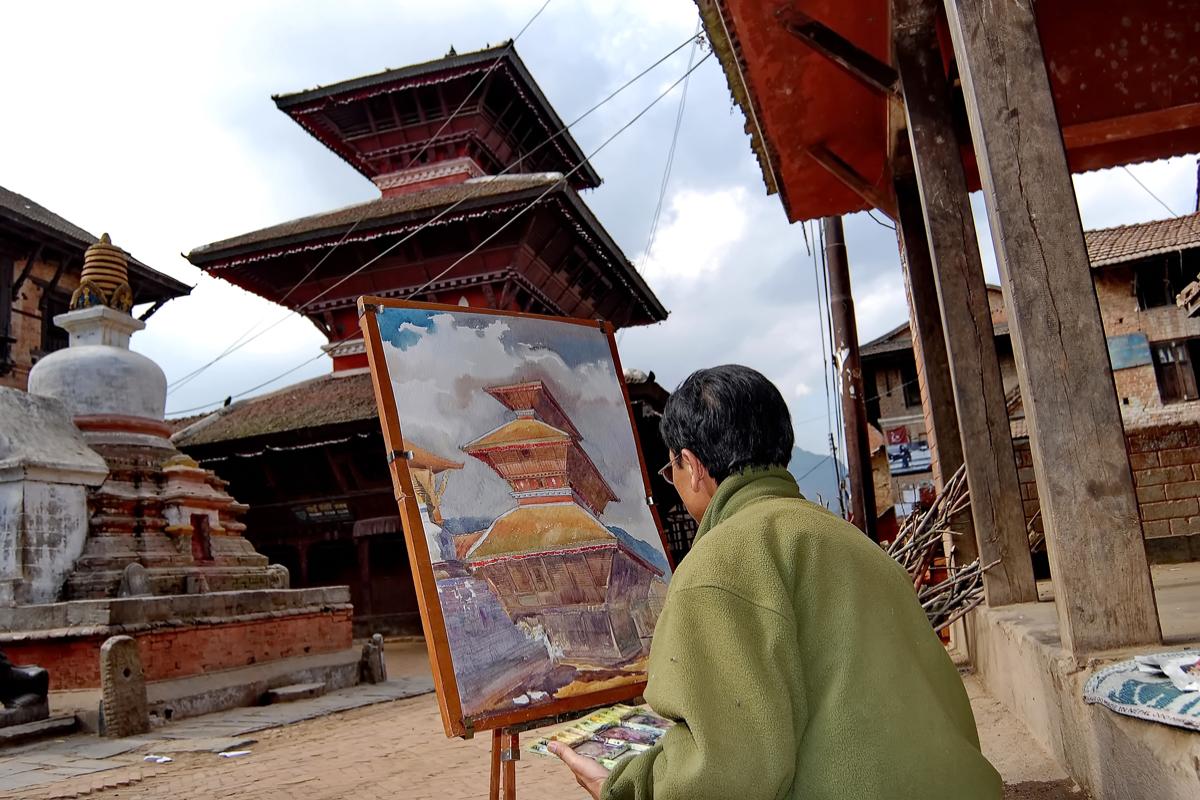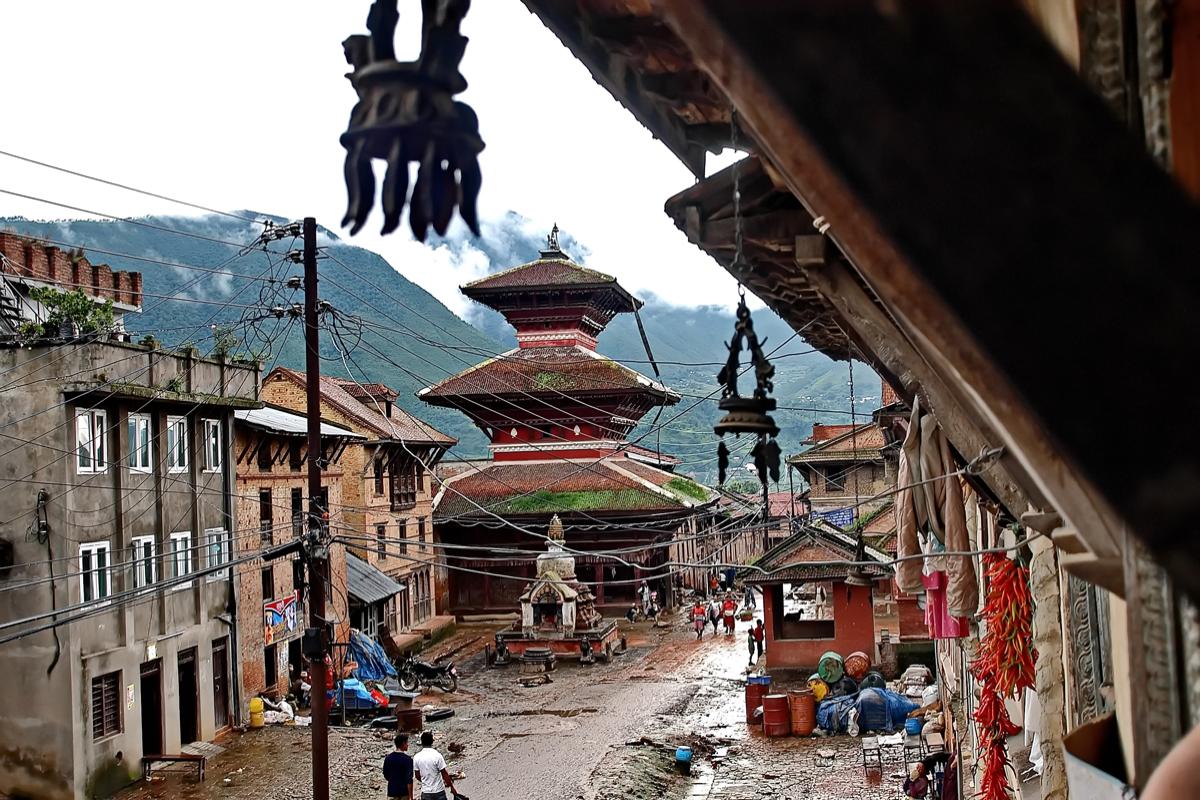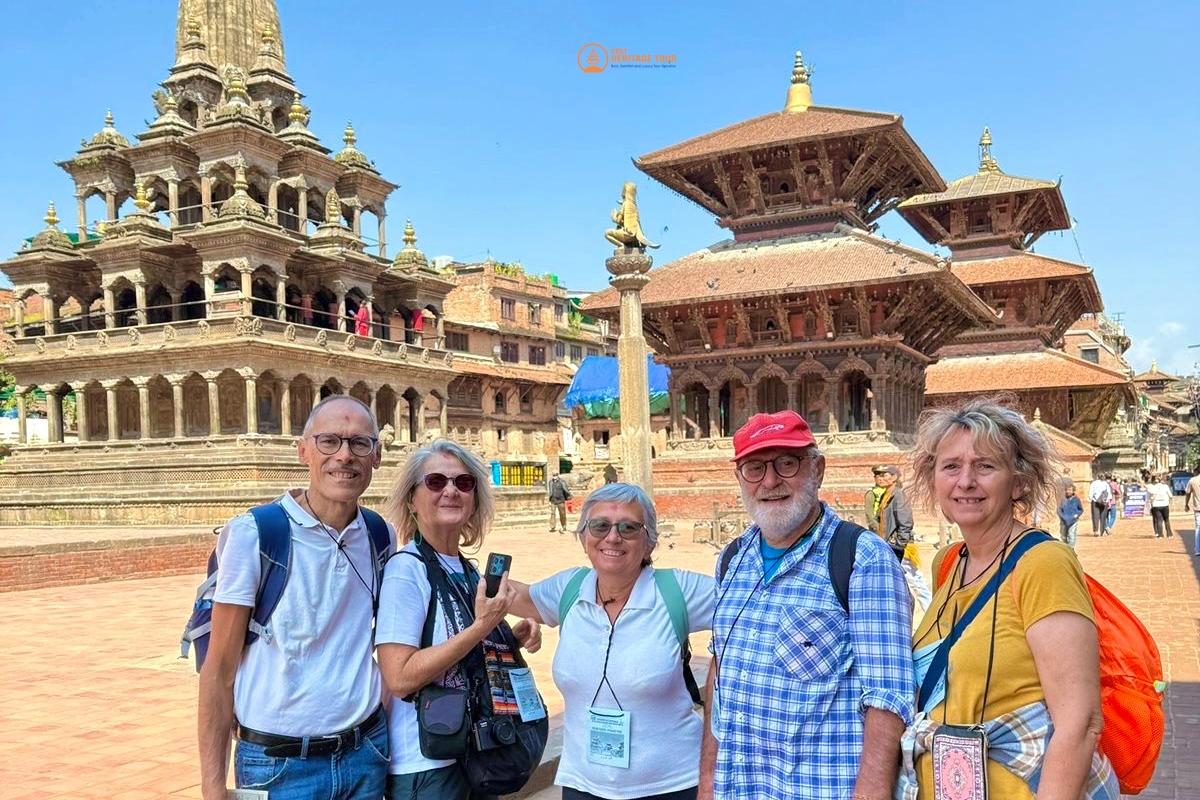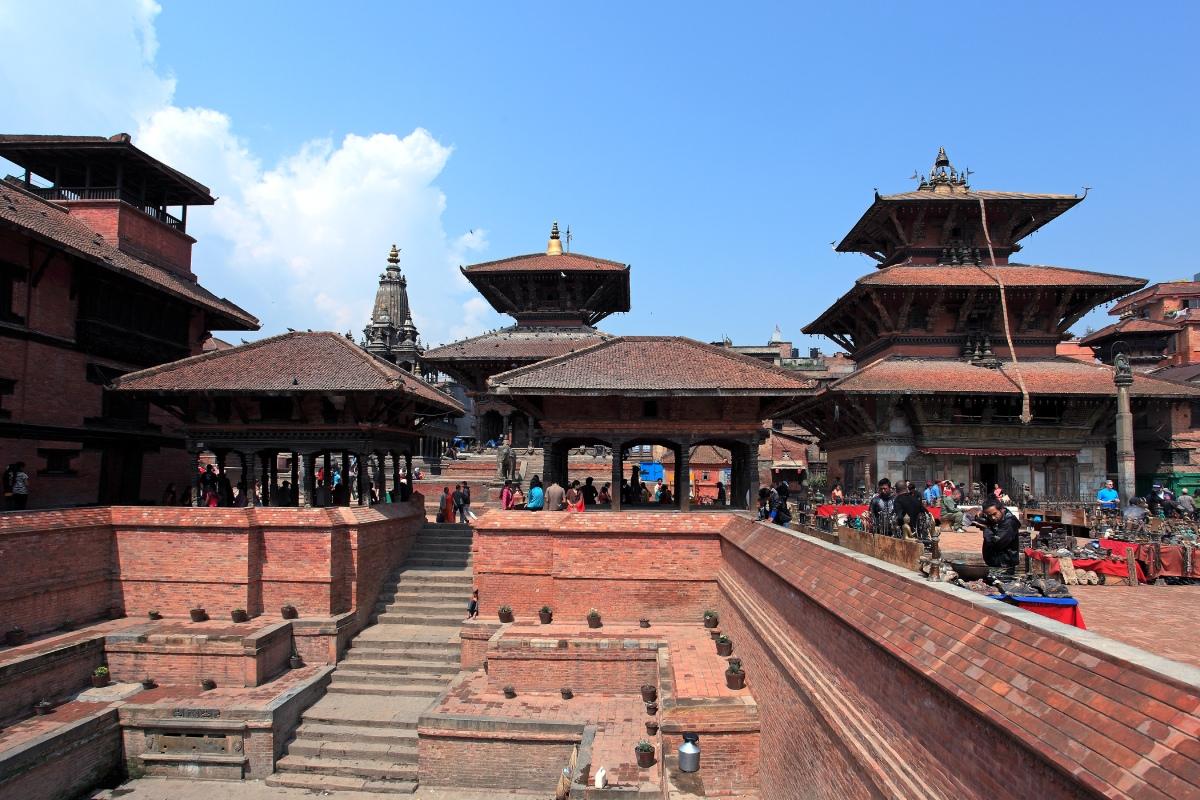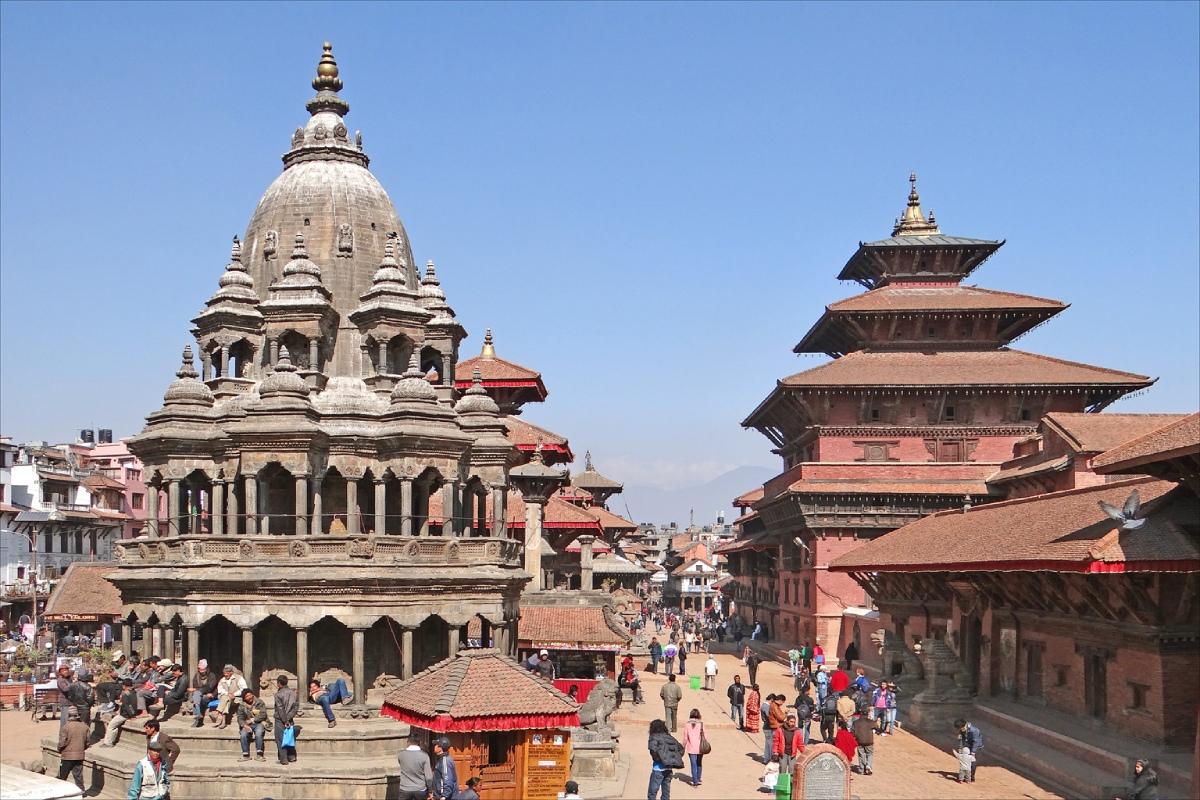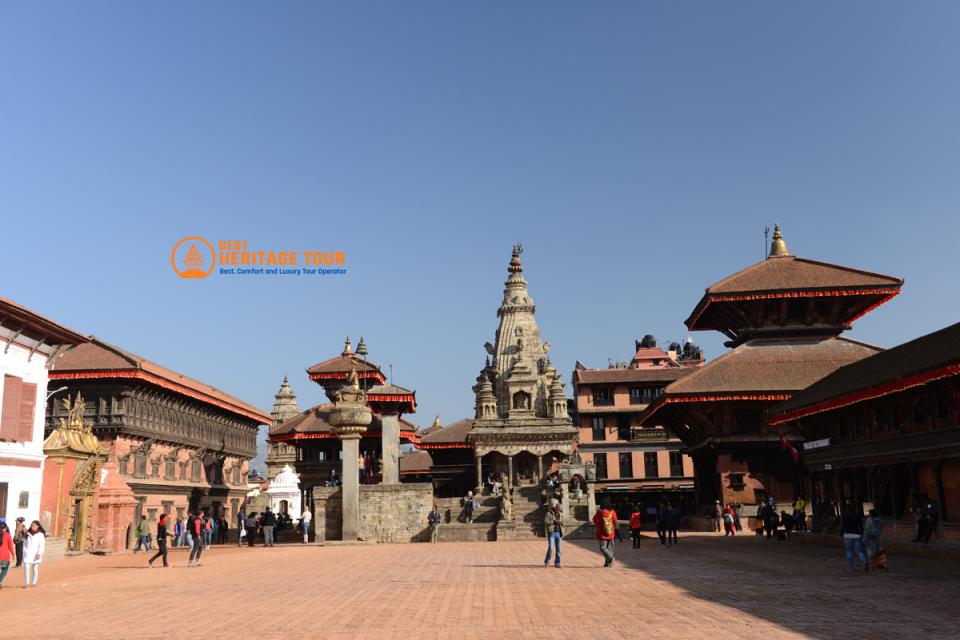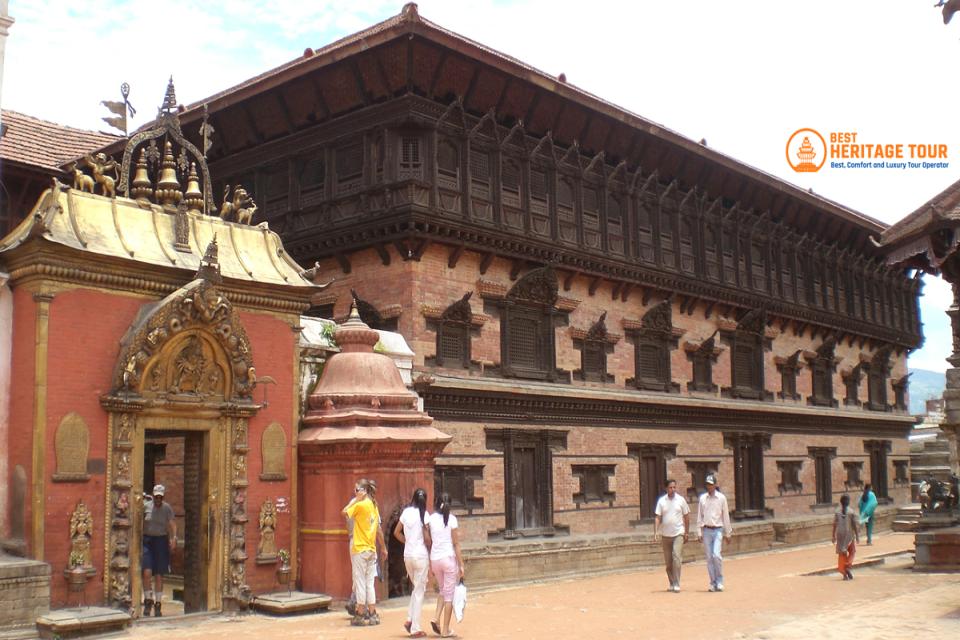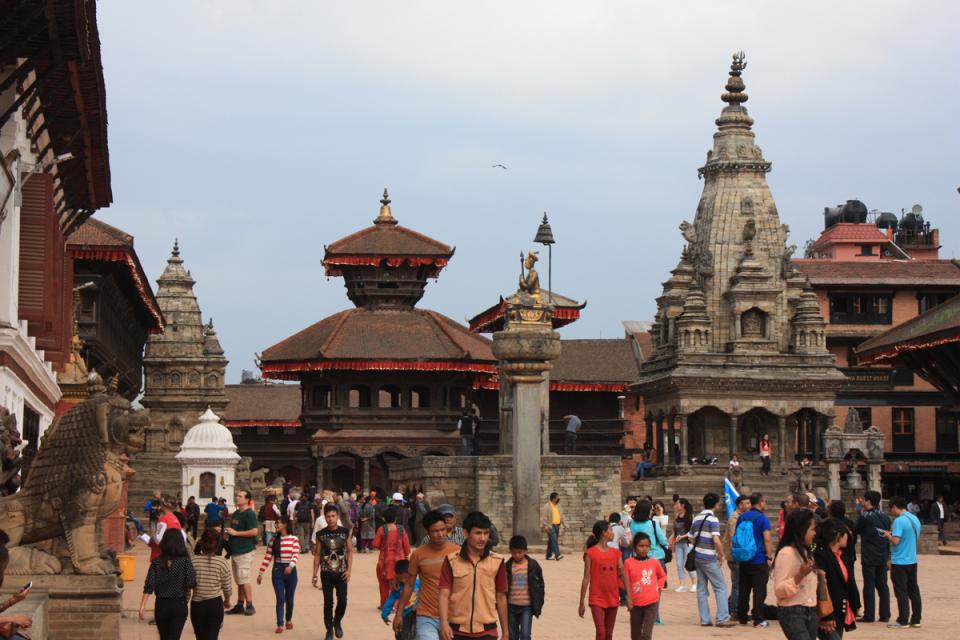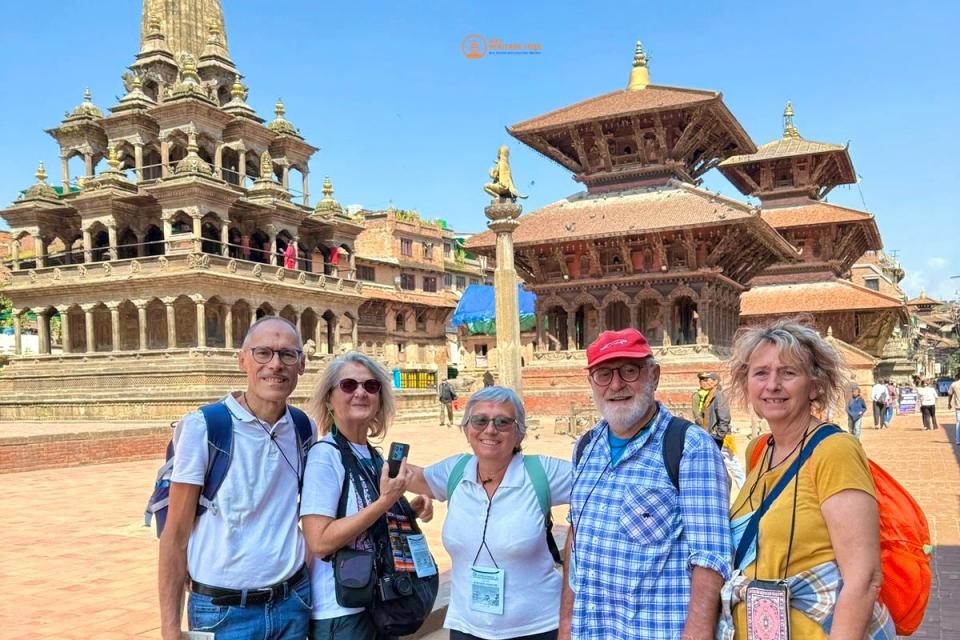Patan, Bungamati and Khokana Heritage Tour - 1 Day
Insight on Patan, Bungamati and Khokana Heritage Tour
This one-day tour takes you through the cultural heart of the Kathmandu Valley, exploring the historic Newari villages of Patan, Bungamati, and Khokana. Visit the UNESCO-listed Patan Durbar Square, admire ancient temples and intricate wood carvings, and discover the craftsmanship of local artisans. Experience the spiritual significance of the Rato Machhendranath Temple and Shikali Mai Temple, and witness traditional Newari village life in Bungamati and Khokana. This tour offers a unique opportunity to immerse yourself in the rich history, art, and culture of Nepal’s ancient communities.
Trip at a Glance
Key Highlights
- Visit Patan Durbar Square, a UNESCO World Heritage Site, known for its stunning Newar architecture, including the Krishna Mandir and Hiranya Varna Mahavihar (Golden Temple).
- Visit Patan Museum that showcases a rich collection of traditional art and artifacts that reflect Nepal’s cultural heritage.
- Expolre the Rato Machhendranath Temple in Bungamati.
- Witness exceptional woodcarving and weaving by local artisans, preserving traditional medieval culture.
- Explore Khokana, famous for its mustard oil production and features the Shikali Mai Temple, dedicated to the local goddess.
- Enjoy the picturesque landscapes and stunning vistas of the surrounding valley.
Benefit of Patan, Bungamati and Khokana Tour with BHT
- Experienced and professional tour guides enhance your understanding of each site.
- Travel in comfort with a private vehicle, ensuring a personalized experience.
- Tailored itineraries cater to your interests for a meaningful journey.
- Smooth and efficient transfers eliminate the stress of public transportation.
- Prioritized safety with reliable transportation and careful planning.
- Convenient booking and reservation process
- Multiple communication channels (Email, WhatsApp, Facebook, WeChat, Viber, Skype, Zoom)
- All logistical arrangements, including permits and transportation, are handled.
- 24/7 phone support at +977-9851149197/+9779810043046
Trip Overview
This one-day tour offers a deep dive into the cultural and historical heart of the Kathmandu Valley, exploring the traditional Newari villages of Patan, Bungamati, and Khokana.
You’ll begin your journey at Patan Durbar Square, a UNESCO World Heritage Site celebrated for its exceptional Newar architecture. The square is surrounded by beautiful temples, shrines, and courtyards, with highlights such as the Krishna Mandir, an intricately carved stone temple dedicated to Lord Krishna, and the Hiranya Varna Mahavihar (Golden Temple), known for its golden facade and spiritual significance. You’ll also visit the Patan Museum, which houses an impressive collection of traditional Nepali art and artifacts, offering insight into the region's rich cultural heritage.
Next, you will head to Bungamati, a charming, centuries-old village famous for its woodcarving craftsmanship. Located just 10 kilometers from Kathmandu, Bungamati remains largely untouched by rapid development, preserving its medieval character. The village is known for its skilled artisans, who create exquisite wooden items using techniques passed down through generations. As you stroll through the streets, you’ll see locals-men, women, and children-engaged in various traditional activities such as weaving, chatting, and working under the sun. At the heart of Bungamati is the Rato Machhendranath Temple, dedicated to the valley's patron deity. This temple plays an important role in one of the Kathmandu Valley’s most significant festivals, during which the statue of Rato Machhendranath is paraded between Patan and Bungamati in a grand procession. The temple, with its unique architectural style, is a key symbol of the region’s religious and cultural identity. Bungamati’s woodcarvers are particularly renowned for their craftsmanship, and you’ll have the chance to purchase handmade wooden items directly from artisans who work from home.
The tour continues to Khokana, a picturesque Newari village located just north of Bungamati. Khokana is famous for its traditional mustard oil production, a practice that has been passed down through generations. The village’s most notable feature is the Shikali Mai Temple, dedicated to the local goddess, Shikali Mai, who is believed to protect the villagers from harm. The temple plays a crucial role, especially during times of illness or disaster, when it is used in rituals for healing and protection. Khokana offers a serene environment, with narrow lanes and traditional homes, providing a peaceful glimpse into rural life in the Kathmandu Valley.
Throughout the day, you’ll experience the timeless traditions, art, and spirituality that define these historic villages, making this tour a unique journey through the cultural soul of Nepal. From the architectural splendor of Patan Durbar Square to the artistic heritage of Bungamati and the tranquil atmosphere of Khokana, this tour offers an enriching experience of the Kathmandu Valley’s enduring cultural identity.
Itinerary
Morning
Pick Up from Hotel
- You will be picked up from your hotel in Kathmandu and driven to Patan Durbar Square, located just 10 kilometers from the city center.
Arrival at Patan Durbar Square
- Patan Durbar Square is a UNESCO World Heritage Site and one of the most beautiful squares in Nepal, known for its stunning Newar architecture and ancient temples. Spend time exploring the square and the surrounding areas.
- Krishna Mandir: This intricately carved stone temple, dedicated to Lord Krishna, is a highlight of the square, showcasing fine craftsmanship in stone carving.
- Hiranya Varna Mahavihar (Golden Temple): Admire the golden facade of this spiritual and architectural gem, an important Buddhist site in Patan.
- Patan Museum: Located in the former royal palace, the museum features an impressive collection of traditional Nepali art and artifacts, offering a glimpse into the cultural heritage of the Kathmandu Valley.
Depart from Patan to Bungamati
- After exploring Patan, you will depart for Bungamati, a traditional Newari village located about 10 kilometers away.
Late Morning
Arrival at Bungamati
- Upon arriving at Bungamati, you’ll begin exploring this ancient village, which has retained much of its medieval charm.
- Local Crafts and Artisans: Bungamati is known for its skilled woodcarvers, and as you walk along the streets, you’ll see artisans working on intricate wooden items such as statues, masks, and household decorations. You’ll have the opportunity to purchase handmade goods directly from the artisans.
- Rato Machhendranath Temple: This temple is dedicated to Rato Machhendranath, the patron deity of the Kathmandu Valley. The temple is a vital part of the region’s cultural and religious life, especially during the grand procession when the statue of the deity is paraded between Patan and Bungamati.
- Daily Life in Bungamati: Wander the narrow streets of the village, where locals engage in traditional activities such as weaving, hand-sewing, and working in their homes. The vibrant atmosphere reflects the strong cultural traditions that have been passed down through generations.
Visit the Karya Binayak Temple
- Between Bungamati and Khokana, you’ll stop at the Karya Binayak Temple, dedicated to Ganesh, the elephant-headed god of wisdom and remover of obstacles. From this location, enjoy panoramic views of the Bungamati valley and the surrounding foothills.
Afternoon
Depart for Khokana
- After your visit to Bungamati, you will continue your journey to the neighboring village of Khokana, which is located just north of Bungamati.
Arrival at Khokana
- Khokana is a quaint Newari village known for its traditional mustard oil production and serene rural life.
- Shikali Mai Temple: The Shikali Mai Temple is the central attraction in Khokana, devoted to the local goddess Shikali Mai, who is revered for her protection of the villagers from harm. This temple plays an important role during times of illness and disasters, when it is used for healing rituals.
- Mustard Oil Production: Khokana has a long tradition of mustard oil production. You’ll have the chance to see the process and learn about this age-old practice that supports the local economy.
- Village Walk: Take a leisurely walk through the narrow lanes of Khokana, passing traditional Newari houses, small shrines, and lush green fields. The village offers a peaceful glimpse into rural life in the Kathmandu Valley, far from the hustle and bustle of the city.
Explore the Scenic Views of Khokana
- Take some time to relax and enjoy the scenic views of the surrounding landscape, including the rolling hills and agricultural fields. This tranquil environment provides a perfect backdrop for photos and reflection.
- Enjoy a short break to sample local snacks or drinks while interacting with the villagers, learning more about their way of life and traditions.
Late Afternoon
Depart from Khokana to Kathmandu at your Hotel
- After spending the afternoon in Khokana, you will head back to Kathmandu, where you can relax and reflect on the rich cultural experiences of the day.
- You will be dropped off at your hotel in Kathmandu, concluding your full-day tour of Patan Durbar Square, Bungamati, and Khokana.
What is included?
- Pick-up from the hotel & Transfer to the heritage site.
- Driver salary allowances.
- Transfer back to Hotel.
What is not included?
- Monument entry fees during a sightseeing tour
- Personal expenses
- Food and drinks
- Tips to guide or driver
- An experienced local tour guide having deep knowledge about these places.
- Entry fees
- All government taxes 13%, SSF, and 10% service charges
Route Map
Equipment
- Comfortable Footwear: As the tour involves walking through villages and exploring historical sites, comfortable walking shoes are recommended.
- Sunscreen: To protect yourself from sun exposure, especially if you are touring outdoors during the day.
- Hat or Cap: A wide-brimmed hat or cap to shield your face and eyes from the sun.
- Camera: To capture the beautiful architecture, local culture, and scenic views throughout the day.
- Water Bottle: Staying hydrated is essential, so bring a reusable water bottle.
- Light Jacket or Sweater: The weather can vary, so packing a light jacket or sweater will ensure comfort throughout the day.
- Small Backpack or Bag: For carrying your essentials like water, snacks, sunscreen, and any personal items.
- Cash: For any personal expenses such as souvenirs or snacks, as well as tips for the guide and driver.
- Travel Adapter/Charger: If you're bringing electronic devices, don’t forget a charger or travel adapter for your phone or camera.
- Notebook/Journal: If you like to take notes or jot down thoughts during the tour, bringing a small notebook or journal can be handy.
- Personal Medications: If you have any specific medical needs, be sure to bring necessary medications or supplies.
Trip Info
Things to Consider During the Patan Durbar Square, Bungamati, and Khokana Tour
-
Footwear: Wear comfortable, sturdy shoes suitable for uneven terrain and cobblestone paths, as you’ll be walking through villages and temples.
-
Respect Religious Sites: Be mindful of local customs when visiting temples, such as removing shoes before entering and avoiding pointing your feet at sacred objects.
-
Cultural Sensitivity: Approach interactions with local communities with kindness and respect, especially in rural Newari villages like Bungamati and Khokana.
-
Stay Hydrated and Protected from the Sun: Carry water, sunscreen, and a hat to stay comfortable during the day, particularly when walking outdoors.
-
Camera Etiquette: Always ask permission before photographing people, especially in temples or rural areas where privacy is valued.
-
Local Currency: Carry small amounts of Nepali Rupees for personal expenses such as snacks, souvenirs, or small donations to temples.
Review
Best tour to know authentic newari culture
Must say Mr Anil and Best heritage tour did best job during arranging this tour. This tour allows me to explore the authentic Newari culture in traditional village of Patan,...
View Detailexperiencing the newari hospitality
I saw many ancient buildings and typical Newari lifestyle. Talking to the people and knowing their native lifestyle and culture was an amazing experience. I got to taste the...
View DetailExploring the Newari Villages
A perfect tour to experience the true Newari culture and lifestyle. From the roaming around Patan durbar square to exploring the newari villages of Bungamati and Khokana, this tour...
View Detailwell guided newari villages tour
Such a great newari culture targeted tour in Kathmandu valley. A well- managed newari village tour guided by an experienced guide Lokdeep. Must try tour for those who want to fully...
View DetailFAQ's
While Nepali is the primary language, most staff members in lodges speak English, and some may even speak other languages. Communication should not be an issue for international tourists.
It’s advisable to be up-to-date on routine vaccinations, including hepatitis A and typhoid. Talk to your doctor about the vaccinations you need for Nepal.
The majority of international flights arrive at Tribhuvan International Airport, which is located in Kathmandu. From this location, travelers can connect to Lukla to commence their trekking journey.
You typically need a valid passport, a completed visa application form, and a passport-sized photo. Payment can be made in cash or via card at the airport.
Yes, tourist visas are eligible for extension at the Department of Immigration located in Kathmandu. Ensure you have a valid reason and required documents for the extension.
If you wish to extend your stay in Nepal beyond your visa’s initial duration, you can do so by applying at the Department of Immigration in Kathmandu. Extensions are available for a maximum of 30 days, and it’s recommended to apply before your current visa expires. Best Heritage Tour can help you with the extension process if required during your Australian Camp Trek.
The Patan, Bungamati and Khokana Tour is a culturally rich journey through three historic towns in Nepal: Patan, Bungamati, and Khokana. This full-day tour, operated by Best Heritage Tour, offers a deep dive into ancient Newar culture, traditional architecture, temples, and local lifestyles, making it a must-see experience for anyone interested in Nepal’s heritage.
The highlights include visits to Patan Durbar Square, known for its medieval architecture, the serene village of Bungamati, famous for its wood carving traditions, and the picturesque Khokana village, home to traditional Newari culture. The tour allows participants to explore historic sites, local craftsmanship, and beautiful temples, all guided by experts from Best Heritage Tour.
Patan Durbar Square, also known as Lalitpur Durbar Square, is a UNESCO World Heritage Site located in the heart of Patan, one of the oldest cities in the Kathmandu Valley. The square has been the center of Patan’s religious and royal activities for centuries, featuring stunning examples of Newar architecture. Patan Durbar Square is renowned for its ancient temples, palaces, and courtyards, which highlight the exceptional craftsmanship of the Malla era. The area is historically significant as it was once the residence of the Malla kings.
Patan Durbar Square is famous for its exquisite architecture, which includes intricately carved wooden windows, stone sculptures, and impressive temples. The square is home to several important landmarks such as the Mahabouddha Temple, Hiranya Varna Mahavihar, and the former Royal Palace. These structures embody the vibrant cultural heritage and artistic excellence of the Newar community. The square is also renowned for its vibrant festivals, such as the Patan Jatra, which attracts both locals and tourists.
Patan Durbar Square is considered an architectural marvel due to its blend of Hindu and Buddhist influences, seen in its temples, shrines, and palaces. The square is an exceptional example of Nepalese architecture with its pagoda-style roofs, elaborate woodwork, and detailed stone carvings. Notable structures like the Mahabouddha Temple, with its thousands of Buddha images, and the golden gates of the Royal Palace exemplify the artistry that has been preserved through the centuries.
Some must-see attractions in Patan Durbar Square include the Royal Palace complex, which houses the Patan Museum showcasing religious artifacts and sculptures, the Mahabouddha Temple, often referred to as the "Temple of a Thousand Buddhas," and the Hiranya Varna Mahavihar, a three-story golden pagoda. The square is also home to the famous Keshav Narayan Chowk and numerous smaller shrines and statues scattered throughout the area, offering a glimpse into Nepal's religious history and artistic achievements.
Bungamati is a traditional Newar village located in the Kathmandu Valley, known for its rich cultural heritage and historical significance. The village is well-known for its historic temples, such as the Rato Machhindranath Temple, which is devoted to the rain god. Bungamati is also renowned for its traditional wood carving, with local artisans continuing centuries-old craft techniques, making it a center for preserving Newar culture and craftsmanship.
During a visit to Bungamati village, you'll experience a charming mix of ancient temples, traditional houses, and artisan workshops. Key highlights include the Rato Machhindranath Temple, the oldest temple in the village, and local wood carving workshops where visitors can watch artisans at work. The village is also famous for its narrow alleyways, old stone structures, and lively community life, offering a glimpse into rural Newar culture.
Bungamati village holds deep cultural significance, especially within the Newar community. The village is home to the Rato Machhindranath, the most important deity of the Newar people, whose annual chariot procession is one of the largest and most colorful festivals in the Kathmandu Valley. Additionally, Bungamati's tradition of wood carving has been passed down for generations, making it an important center for the preservation of Nepali art and craftsmanship.
Yes, Bungamati village is home to several cultural festivals throughout the year, the most notable being the Rato Machhindranath Jatra. This vibrant festival celebrates the rain god, Rato Machhindranath, and features a grand chariot procession, traditional dances, and local rituals. The festival attracts visitors and pilgrims from across Nepal, offering a unique insight into the customs, traditions, and religious practices of the Newar community. Other smaller cultural events also take place throughout the year, showcasing local traditions and arts.
Khokana village is renowned for its rich cultural heritage, traditional Newar architecture, and the production of mustard oil. The village is home to several historical temples, including the revered Rudrayani Temple. Khokana is also famous for its ancient agricultural practices and well-preserved traditional lifestyle, providing a glimpse into rural life in Nepal. Its peaceful environment and authentic cultural experiences make it a unique destination for those seeking a more off-the-beaten-path visit.
A visit to Khokana village offers a chance to explore its beautiful traditional architecture, narrow streets, and ancient temples. The village is particularly famous for its mustard oil extraction process, which has been practiced for centuries. Visitors can watch local artisans at work, experience the village's vibrant culture, and enjoy the serene surroundings. The Rudrayani Temple, dedicated to the goddess of power and prosperity, is a must-see attraction, along with the village's many traditional houses and shrines.
Khokana village holds significant importance in Nepali culture, especially for the Newar community. The village’s ancient mustard oil production process is a key element of its economy and cultural identity. Additionally, the Rudrayani Temple in Khokana is an important religious site, and the village is known for its preservation of Newar traditions, including festivals, rituals, and traditional architecture. It offers visitors a unique look into the lifestyle and customs that have shaped the Kathmandu Valley for centuries.
Yes, Khokana village is known for its traditional mustard oil production, which has been a key part of the local economy for generations. The village's artisans use traditional methods to extract oil from mustard seeds, and visitors can observe this age-old process. Additionally, Khokana is known for its traditional Newar crafts, including pottery, wood carving, and the creation of religious artifacts, which are still practiced by local artisans. These crafts provide a unique cultural insight into the village's heritage.
The Patan, Bungamati and Khokana Tour lasts approximately 7 to 8 hours, providing a full day of exploration across these three culturally significant locations. The tour is designed to be comprehensive, giving ample time to experience the essence of each site at a relaxed pace.
Yes, the Patan, Bungamati and Khokana Tour is suitable for families of all ages. The tour’s pace is gentle, with plenty of opportunities to explore historical landmarks and engage with local culture. It’s a wonderful way for families to experience Nepal’s rich cultural heritage together.
The cost of the Patan, Bungamati and Khokana Tour varies depending on the number of participants and specific requests. The price generally includes transportation, a knowledgeable guide, and entry fees to the historic sites. For an accurate quote, it’s best to contact Best Heritage Tour directly.
The Patan, Bungamati and Khokana Tour package typically includes transportation, a professional guide, and entry fees to the key heritage sites. Meals and personal expenses are not usually included, though they may be arranged upon request. For more details, you can reach out to Best Heritage Tour.
The best time to take the Patan, Bungamati and Khokana Tour is during the dry season, from October to April. These months offer pleasant weather and clear skies, making it ideal for outdoor exploration of Patan, Bungamati, and Khokana.
Yes, the Patan, Bungamati and Khokana Tour can be customized to meet specific interests or needs. If you have particular sites you'd like to focus on or specific cultural experiences you'd like to add, Best Heritage Tour can tailor the itinerary accordingly.
Yes, entrance fees to the heritage sites like Patan Durbar Square, the temples in Bungamati, and the historic sites in Khokana are included in the Patan, Bungamati and Khokana Tour. However, additional personal expenses or special activities may be extra.
Yes, the Patan, Bungamati and Khokana Tour is usually conducted in English, and the guide provided by Best Heritage Tour will offer detailed explanations in English about the historical, cultural, and architectural significance of each site visited.
To book the Patan, Bungamati and Khokana Tour you can visit the Best Heritage Tour website and fill out the booking form or contact their customer service directly. Booking in advance is recommended, particularly during peak seasons, to secure availability.
Yes, the Patan, Bungamati and Khokana Tour is available throughout the year. However, the best experience is during the dry season from October to April, as the weather is more favorable for sightseeing and outdoor activities.
The Patan, Bungamati and Khokana Tour involves moderate walking as you explore the various heritage sites. The walking pace is relaxed, and most of the walking will be in the historic town centers. However, it's advisable to be prepared for some walking on uneven surfaces.
On the Patan, Bungamati and Khokana Tour you can expect to experience Newari culture, traditional architecture, wood carving, and local crafts. You will visit ancient temples, encounter local artisans, and have opportunities to learn about the history and customs of the area.
There are no specific age restrictions for the Patan, Bungamati and Khokana Tour. The tour is suitable for people of all ages, including children and senior citizens, as long as they are physically able to walk around the sites comfortably.
The weather during the Patan, Bungamati and Khokana Tour is generally pleasant, especially from October to April when the skies are clear and the temperatures are moderate. The daytime temperatures range from 15°C to 25°C, while evenings can get cooler, so it’s advisable to bring a light jacket.
While the weather is usually stable, especially during the dry season, rain showers are possible, particularly in the monsoon months from June to September. It’s recommended to check the weather forecast and be prepared for slight changes in weather conditions during the Patan, Bungamati and Khokana Tour.
For the Patan, Bungamati and Khokana Tour wear light, breathable clothing in warmer months and bring a sweater or light jacket for cooler evenings. If you're traveling during the monsoon season, a waterproof jacket or umbrella is recommended due to occasional rainfall.
The average temperature in Kathmandu during the Patan, Bungamati and Khokana Tour ranges between 15°C and 25°C from October to April. The weather is generally mild, with cooler evenings, making it perfect for outdoor sightseeing and exploration of the historical sites.
During the summer months (June to September), the weather can be hot and humid, with temperatures reaching up to 30°C. There’s also a higher chance of rainfall. For the Patan, Bungamati and Khokana Tour wear light clothing, sunscreen, and bring an umbrella or raincoat to stay comfortable.
Weather conditions may impact the tour slightly, especially during the rainy season, when paths may be slippery or certain sites may be less accessible. However, the Patan, Bungamati and Khokana Tour generally operates regardless of weather, with adjustments made for safety.
Yes, the Patan, Bungamati and Khokana Tour is quite enjoyable in the winter months (November to February), with clear skies and cool, comfortable temperatures ranging from 5°C to 15°C. Warm clothing is recommended for the morning and evening tours.
The best seasons for the Patan, Bungamati, and Khokana Tour are spring (March to May) and autumn (October to November). During these times, the weather is mild, clear, and perfect for exploring the outdoor heritage sites.
For international travelers visiting Nepal for the Patan, Bungamati and Khokana Tour a tourist visa is required. Most visitors can obtain a visa on arrival at Kathmandu's Tribhuvan International Airport or apply online before traveling. It’s advisable to check with your local embassy or the official Nepal immigration website for specific visa regulations.
Kathmandu, the starting point for the Patan, Bungamati and Khokana Tour is well-connected by international flights. You can fly directly into Tribhuvan International Airport from major cities worldwide. Once in Kathmandu, the tour operator, Best Heritage Tour, will arrange transportation to the tour's departure point.
Yes, all foreign nationals require a visa to enter Nepal to participate in the Patan, Bungamati and Khokana Tour. Visas can be obtained on arrival at the airport or in advance through the Nepalese embassy. Best Heritage Tour can provide additional guidance on visa procedures if needed.
If you’re obtaining a visa on arrival, the process is relatively quick and usually takes around 15-30 minutes at the Tribhuvan International Airport. Alternatively, if applying online before your trip, ensure to allow sufficient processing time, which generally takes a few days. For expedited services, you may need to check with the Nepal embassy or consulate.
Yes, a tourist visa is sufficient for the Patan, Bungamati and Khokana Tour. The visa allows you to participate in sightseeing and cultural tours within Nepal. Ensure that your visa is valid for the duration of your stay.
Yes, the Patan, Bungamati and Khokana Tour is open to solo travelers. Best Heritage Tour provides individual packages, allowing you to join a group or opt for a private guide and transportation for a personalized experience.
Best Heritage Tour does not directly process visas, but they can provide you with useful information and assistance regarding visa requirements. You can reach out to them for guidance on the application process and any other travel-related inquiries.
Best Heritage Tour accepts various payment methods, including credit/debit cards, bank transfers, and online payment platforms. They also accept payments in major currencies like USD, EUR, and NPR. You can inquire directly with Best Heritage Tour for specific payment options and details.
The cost of the Patan, Bungamati and Khokana Tour generally covers transportation, entry fees, and the guide. However, any personal expenses such as meals, souvenirs, or additional activities are not included. It’s recommended to bring some extra cash for these optional costs.
Tipping is not included in the cost of the Patan, Bungamati and Khokana Tour though it is appreciated for the guide and driver. Tipping is optional but recommended for good service. The amount is at your discretion, and Best Heritage Tour can provide guidance if necessary.
To make a payment for the Patan, Bungamati and Khokana Tour you can book online through the Best Heritage Tour website and pay via their secure payment gateway. Alternatively, you can make a bank transfer or pay by card based on the available options listed during booking.
Meals are generally not included in the Patan, Bungamati and Khokana Tour. However, if you wish to have a meal during the tour, Best Heritage Tour can arrange a stop at a local restaurant. You will need to cover the cost of any meals or snacks during the trip.
Best Heritage Tour has a clear refund policy in place for cancellations. Typically, a full refund is available if canceled within a specified time frame (such as 48 hours before the tour). Cancellations made later than this period may incur a fee or partial refund. For precise details, contact Best Heritage Tour.
If you need to cancel, Best Heritage Tour offers a refund based on their cancellation policy. Cancellations made well in advance typically qualify for a full refund, but fees may apply for last-minute cancellations. For the specific refund policy, it’s best to contact Best Heritage Tour directly when making your booking.
The Patan, Bungamati and Khokana Tour does not require advanced physical fitness. However, participants should be able to walk comfortably for a few hours through uneven surfaces and hilly areas. If you have mobility issues, Best Heritage Tour can assist with alternative arrangements.
There is no specific age limit for the Patan, Bungamati and Khokana Tour. The tour is suitable for all age groups, from young adults to senior citizens. Best Heritage Tour ensures the itinerary is accessible for everyone, with considerations made for those with mobility challenges.
People with limited mobility may still participate in the Patan, Bungamati and Khokana Tour. Best Heritage Tour can make necessary arrangements, such as providing a vehicle for easier access to sites and modifying the tour route to accommodate those with mobility issues.
If you have specific allergies or health conditions, it’s advisable to inform Best Heritage Tour in advance. The tour involves light walking and visiting open-air sites, but they can help accommodate your needs to ensure your comfort and safety during the 'Patan, Bungamati and Khokana Tour.
The Patan, Bungamati and Khokana Tour is a day tour, so accommodation is not included. However, Best Heritage Tour can assist in arranging accommodation in Kathmandu if you wish to stay longer before or after the tour. You can choose from budget hotels to luxury options based on your preference.
Meals are generally not included in the Patan, Bungamati and Khokana Tour. However, there will be opportunities to stop at local restaurants for lunch and snacks. The costs of meals will be borne by the traveler. Best Heritage Tour can suggest great local dining options during the trip.
Yes, vegetarian food options are widely available during the Patan, Bungamati and Khokana Tour. If you have specific dietary preferences, it's recommended to inform Best Heritage Tour in advance so they can arrange meals accordingly at local eateries.
Best Heritage Tour can assist in arranging special dietary meals, such as gluten-free, vegan, or kosher options, at local restaurants along the tour. However, it's best to inform them in advance so that they can make the necessary arrangements.
On the Patan, Bungamati and Khokana Tour you will have the chance to stop at local restaurants during your visit to the heritage sites. Best Heritage Tour will suggest spots for a delicious, authentic meal. The choice of meals will depend on the available options at the time of the tour.
Yes, you will have the opportunity to enjoy lunch during the Patan, Bungamati and Khokana Tour. While lunch is not included in the tour price, you will visit a local restaurant or cafe, where you can enjoy a traditional meal at your own expense. Best Heritage Tour can guide you on where to dine.
Snacks are not typically included in the Patan, Bungamati and Khokana Tour. However, you can stop at local shops or stalls to purchase snacks along the way. Best Heritage Tour will provide you with advice on where to find snacks during the trip if needed.
Yes, you can bring your own food during the Patan, Bungamati and Khokana Tour. However, it’s recommended to have local meals to enjoy the cultural experience. Best Heritage Tour can help you find suitable places to store or consume your own snacks if necessary.
For the Patan, Bungamati and Khokana Tour it’s recommended to pack comfortable walking shoes, a hat, sunscreen, a water bottle, a camera, and light layers of clothing. If visiting in the winter months, you may want to bring a jacket. Best Heritage Tour will advise on packing essentials based on the season.
Yes, bringing a camera is highly recommended for the Patan, Bungamati and Khokana Tour. The heritage sites, temples, and local villages offer fantastic photo opportunities. Be mindful of the local customs regarding photography, and always ask for permission when photographing people.
Yes, it’s recommended to carry some cash for the Patan, Bungamati and Khokana Tour. While some places may accept credit cards, smaller shops, restaurants, and entry fees may require cash payments. It’s best to have Nepali Rupees (NPR) for such situations.
To protect yourself from the sun on the Patan, Bungamati and Khokana Tour be sure to bring sunscreen, sunglasses, and a wide-brimmed hat. If traveling during the warmer months, a light scarf or shawl can also help shield you from the sun.
Yes, it’s important to bring a water bottle for hydration during the Patan, Bungamati and Khokana Tour especially if you are visiting during the warmer months. Best Heritage Tour recommends staying hydrated, particularly while walking through the heritage sites.
A guidebook is not necessary as Best Heritage Tour provides an experienced local guide who will share in-depth knowledge about the historical and cultural sites. However, if you prefer to bring a guidebook for reference, it can add to your understanding of the sites you visit.
The Patan, Bungamati and Khokana Tour does not require high levels of physical fitness. The tour mainly involves walking around the heritage sites, and while some areas may have uneven ground or stairs, it’s suitable for most people with average fitness levels.
On the Patan, Bungamati and Khokana Tour expect to walk for a few hours as you explore Patan Durbar Square, Bungamati, and Khokana. The walking will be leisurely, with time to rest and enjoy the sights. Comfortable shoes are essential for walking comfortably during the tour.
No, the Patan, Bungamati and Khokana Tour is not tiring. It is designed for people with average fitness levels, as the walking involves exploring historical sites and local villages, with plenty of opportunities to stop and rest. The tour is more about cultural exploration than physical exertion.
Before joining the Patan, Bungamati and Khokana Tour it’s advisable to be in general good health, as the tour involves walking. Remember to stay hydrated and shield yourself from the sun by applying sunscreen and wearing a hat. If you have any health concerns, it's advisable to consult with a healthcare provider before your tour. Best Heritage Tour will provide you with further details on health measures if required.
It is not mandatory to get vaccinations for the Patan, Bungamati and Khokana Tour. However, it’s recommended to consult with your healthcare provider about recommended vaccinations for traveling in Nepal, especially if you plan to travel to rural areas after the tour. Standard vaccines like tetanus and hepatitis A are commonly suggested for travelers.
The Patan, Bungamati and Khokana Tour does not involve significant health risks. The biggest health concern is related to the heat and sun exposure, especially during summer months, so be sure to stay hydrated and wear sunscreen. If you have any medical conditions, it’s best to inform the Best Heritage Tour team prior to the tour.
If you feel unwell during the Patan, Bungamati and Khokana Tour notify your guide immediately. Best Heritage Tour ensures that your comfort and safety are prioritized, and the guide will assist you by either providing rest breaks or directing you to medical assistance if necessary.
Medical assistance is not directly available during the Patan, Bungamati and Khokana Tour but your guide will be able to take you to nearby healthcare facilities if required. It’s always a good idea to carry basic medications, such as pain relievers and any prescribed medicines, during the tour.
On the Patan, Bungamati and Khokana Tour it is important to follow the safety guidelines provided by the guide. These include staying within designated areas, watching your step on uneven surfaces, and being mindful of local customs and traditions. Your guide will ensure you have a safe and enjoyable experience.
The Patan, Bungamati and Khokana Tour can be suitable for people with medical conditions, but it is best to consult with your doctor before the tour, especially if you have heart conditions, mobility issues, or respiratory problems. Inform Best Heritage Tour of any health concerns so that they can tailor the experience to your needs.
While travel insurance is not mandatory for the Patan, Bungamati and Khokana Tour it is highly recommended. Travel insurance can provide coverage for unforeseen events like medical emergencies, trip cancellations, or loss of belongings, giving you peace of mind during the tour.
For the Patan, Bungamati and Khokana Tour it is advisable to get travel insurance that covers medical emergencies, trip cancellations, lost luggage, and emergency evacuation. Make sure the policy covers you for activities related to cultural sightseeing and walking tours.
Best Heritage Tour does not directly sell travel insurance, but they can recommend reliable providers who offer coverage for travelers visiting Nepal. It is advisable to purchase insurance before traveling to ensure that you are fully protected in case of any unforeseen events during the Patan, Bungamati and Khokana Tour.
Yes, most travel insurance policies that cover medical emergencies will provide protection during the Patan, Bungamati and Khokana Tour. Be sure to check that the policy covers any medical treatment needed during your trip and any potential evacuation costs if necessary.
Travel insurance policies that include trip cancellation coverage may help if you need to cancel your participation in the Patan, Bungamati and Khokana Tour. Always confirm the details with your insurance provider and ensure that cancellations due to illness or other emergencies are covered.
If you need to cancel your trip to the Patan, Bungamati and Khokana Tour and you have insurance coverage, you may be able to claim a refund for the tour cost, depending on the terms and conditions of your policy. Always check your insurance policy’s cancellation terms before making any decisions.
Most comprehensive travel insurance policies will cover emergency evacuation costs if needed during the Patan, Bungamati and Khokana Tour. Ensure that your travel insurance includes medical evacuation, especially if you are traveling from areas that are far from medical facilities.
The cost of travel insurance for the Patan, Bungamati and Khokana Tour varies depending on the provider and the level of coverage. On average, insurance policies can cost between 4% to 10% of the total trip cost. It is important to shop around and choose a policy that best meets your needs.
The Patan, Bungamati and Khokana Tour starts from Kathmandu. Best Heritage Tour will provide transportation from your hotel in Kathmandu to the tour's starting point, typically in a private vehicle, making it convenient for you to begin your journey.
Transportation for the Patan, Bungamati and Khokana Tour is provided in a comfortable private vehicle. Best Heritage Tour ensures that all guests are safely transported between the sites, ensuring a smooth experience throughout the day.
Patan, Bungamati, and Khokana are all located within close proximity to Kathmandu, with each site taking approximately 30 minutes to 1 hour to reach by private vehicle. The Patan, Bungamati and Khokana Tour will ensure that transportation is efficient and comfortable.
No, the Patan, Bungamati and Khokana Tour does not require flights, as it is a day tour conducted within the Kathmandu Valley. Transportation will be provided by road, and you will be transported comfortably between the heritage sites.
It is not recommended to use public transportation for the Patan, Bungamati and Khokana Tour as it might not be as convenient or reliable. Best Heritage Tour provides private vehicle transport for a more comfortable and efficient experience.
After completing the Patan, Bungamati and Khokana Tour Best Heritage Tour will arrange for transportation to take you back to your hotel in Kathmandu, ensuring a hassle-free return. If you prefer to explore on your own afterward, your guide will provide guidance.
While taxis are available in Kathmandu, Best Heritage Tour recommends using their own private transportation for the Patan, Bungamati and Khokana Tour. This ensures a more comfortable and reliable travel experience, tailored to the tour's schedule.
If your flight arrives late and you miss the Patan, Bungamati and Khokana Tour it’s best to inform Best Heritage Tour in advance. They may be able to reschedule your tour or offer alternative arrangements depending on availability.
Absolutely! The Patan, Bungamati and Khokana Tour is an excellent choice for group travel. Whether you're traveling with friends, family, or colleagues, Best Heritage Tour will ensure that your group enjoys a seamless and enriching experience while exploring the heritage sites.
In group travel, the Patan, Bungamati and Khokana Tour allows participants to explore the sites together with a guide who provides historical context and insights. The group will travel in a comfortable vehicle, and everyone will enjoy the same itinerary, making it an enjoyable collective experience.
Best Heritage Tour occasionally offers discounts for larger groups on the Patan, Bungamati and Khokana Tour. It's best to inquire in advance for specific group size discounts and to check for any promotions or deals that may apply to your group.
Yes, Best Heritage Tour can accommodate large groups for the Patan, Bungamati and Khokana Tour. The company will arrange adequate transportation and guides, ensuring that everyone in the group can enjoy the tour comfortably and receive detailed attention from the guide.
Solo travel on the Patan, Bungamati and Khokana Tour allows for a more personalized experience. As a solo traveler, you will receive focused attention from the guide and have the flexibility to engage more deeply with the sites. However, you will still enjoy the shared experience of exploring the cultural landmarks with other participants.
It’s recommended to book your spot in advance for both solo and group travel on the Patan, Bungamati and Khokana TourBest Heritage Tour ensures that all travelers have confirmed spots, and early booking guarantees availability, especially during peak seasons.
The Patan, Bungamati and Khokana Tour is great for both solo travelers and groups. Solo travelers benefit from personalized attention, while groups enjoy the camaraderie of exploring the sites together. Best Heritage Tour tailors the experience to ensure that all participants have a fulfilling journey, regardless of travel style.
While wheelchairs may not be widely available at all heritage sites, Best Heritage Tour can help make arrangements for travelers with mobility impairments. It’s best to inform the team in advance so they can provide support and ensure your comfort during the tour.
Yes, strollers can be used during the Patan, Bungamati and Khokana Tour but since the terrain can be uneven, it may not be suitable for all parts of the tour. Best Heritage Tour can suggest areas where a stroller will be most practical, and help with easier routes for young children.

